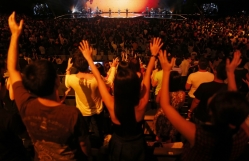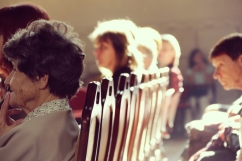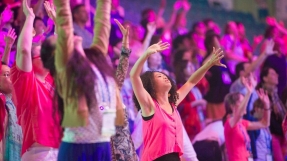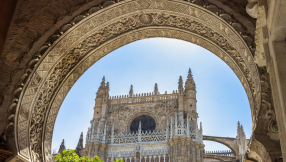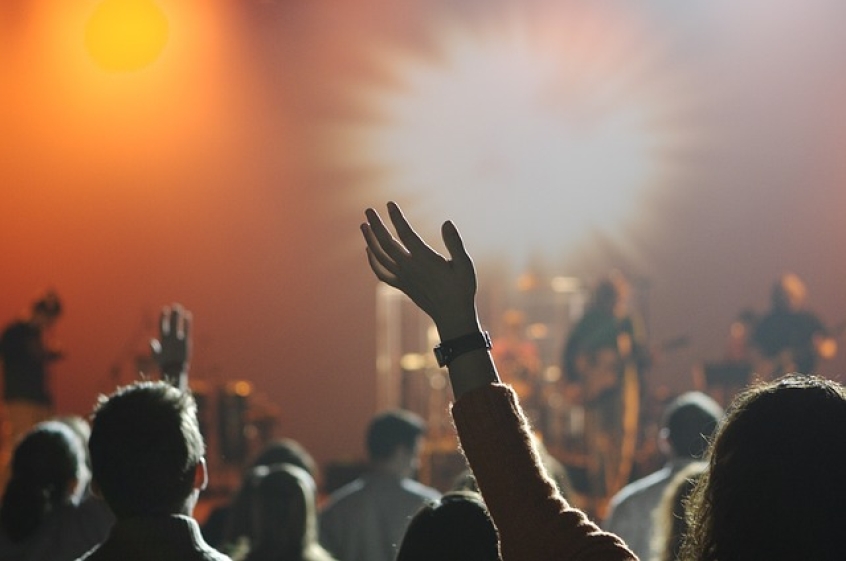
If there's one thing I found really hard to understand when I became a Christian nearly 25 years ago, it was the hand-raising thing. I came to faith in a moderately charismatic church, and spent most holidays during my teens at one Christian festival or another. So from an early (spiritual) age, I was always surrounded by people who meaningfully express themselves in worship using their arms... and if I'm really honest, I never quite understood it, or why there seemed to be such a wide variety in style.
It turns out though, after a bit of investigation, that it's all very biblical. There are tons of mentions of 'lifting holy hands' (1 Timothy 2:8), especially in the Old Testament where it seems to be a natural aspect of prayer and worship (Nehemiah 8:6 for example). But since – Good News Bible apart – Scripture doesn't come with illustrations, this phrase is obviously open to interpretation. And perhaps this explains my confusion: as the following guide demonstrates, those interpretations are wide, varied... and often vividly flamboyant.
Now, this is all intended as an affectionate tribute. It's a fantastic thing to see anyone fully invested in offering praise and worship to God. In fact, I dare say that our diversity of expression even in this relatively trivial thing is another beautiful illustration of our individual uniqueness...
#1 The One-arm Straight Raise
The simplest and safest version, and the one most often seen in the average church, especially when the words of the song being sung include "so we raise up holy hands". Especially handy during a long worship set because you can switch arms when you get tired (it's also fun watching people attempt to disguise this changeover).
#2 The Funky Push
Popular among people with a keen sense of rhythm, and turns the lifting of a hand into a gentle dance move. This is often also accompanied with a very earnest facial expression, which demonstrates to onlookers that you're definitely worshipping, not just rocking out to Rend Collective.
#3 The Half-way House
If you don't want to fully commit, either because it might not be that kind of church or because you've suddenly remembered you're British, you can employ this half-mast option. The hand is raised, but only to about chest-height, as if one is discreetly waving to someone in the opposite pew. Also really easy to pull out of if the worship leader throws in a very dull hymn.
#4 The Clenched Power Fist
An innovation of the younger generation, the raised fist (often accompanied by a slight head bow) is a great way to signify commitment and allegiance to the cause. Its sister variant, the heavenward point, does much the same thing, introducing a bit of urgency into the gesture. I imagine some older congregants could find this a bit threatening, but it's all the rage at Soul Survivor.
#5 The Nervous Nelly
Novice arm-raisers can often fall into this trap - an arm which keeps briefly emerging before being withdrawn, as if the worshipper is doing the Matt Redman Hokey Cokey. Sometimes this is also employed by people who think very carefully about what they're singing and only want to affirm certain statements, at which point it stops becoming the Nervous Nelly, and is transformed into the Penal Substitutionary Atonement Lyric Discomfort Protest. Which isn't half as snappy.
#6 The Rapid Switcher
This one's basically just a dance. Again only employed by pro-level charismatics, this sees the left and right arms being used interchangeably, perhaps swapping at the end of each song line. Anyone showing this level of Holy Hand prowess is almost also employing a rhythmic foot tap and a religiously-appropriate level of bum-wiggling too.
#7 The Full Monty
Both arms aloft, and no hiding place if you start to get tired during the fifth chorus repeat. This is usually the preserve of the holiest and the fittest among us. It's also co-incidentally seems to be a fave among people with really active underarm sweat glands.










